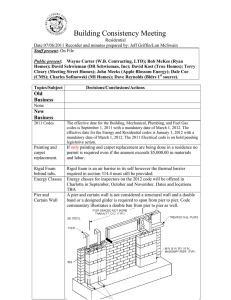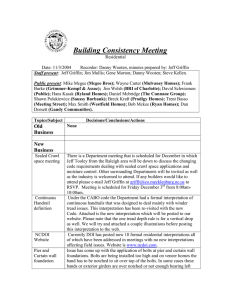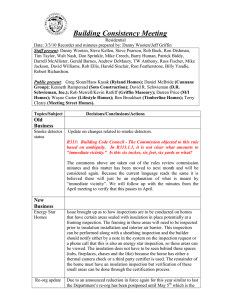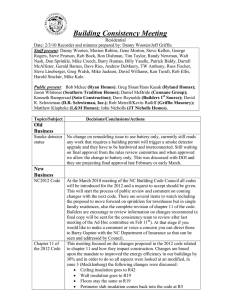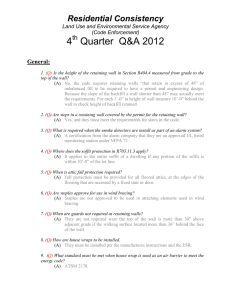Building Consistency Meeting
advertisement
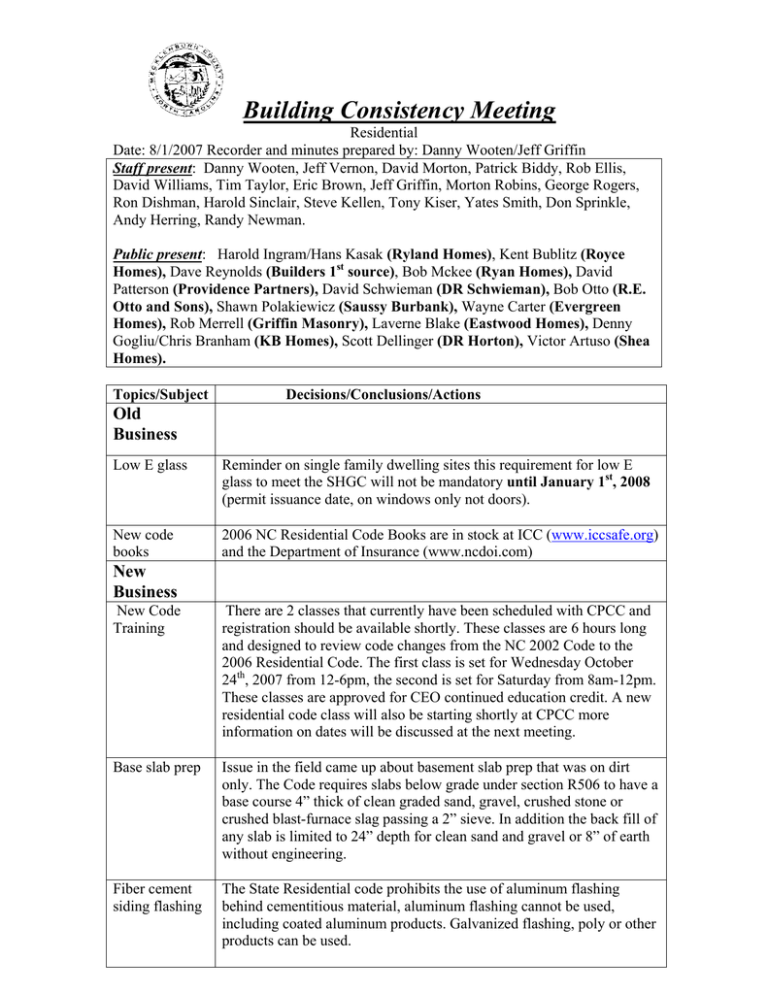
Building Consistency Meeting Residential Date: 8/1/2007 Recorder and minutes prepared by: Danny Wooten/Jeff Griffin Staff present: Danny Wooten, Jeff Vernon, David Morton, Patrick Biddy, Rob Ellis, David Williams, Tim Taylor, Eric Brown, Jeff Griffin, Morton Robins, George Rogers, Ron Dishman, Harold Sinclair, Steve Kellen, Tony Kiser, Yates Smith, Don Sprinkle, Andy Herring, Randy Newman. Public present: Harold Ingram/Hans Kasak (Ryland Homes), Kent Bublitz (Royce Homes), Dave Reynolds (Builders 1st source), Bob Mckee (Ryan Homes), David Patterson (Providence Partners), David Schwieman (DR Schwieman), Bob Otto (R.E. Otto and Sons), Shawn Polakiewicz (Saussy Burbank), Wayne Carter (Evergreen Homes), Rob Merrell (Griffin Masonry), Laverne Blake (Eastwood Homes), Denny Gogliu/Chris Branham (KB Homes), Scott Dellinger (DR Horton), Victor Artuso (Shea Homes). Topics/Subject Decisions/Conclusions/Actions Old Business Low E glass Reminder on single family dwelling sites this requirement for low E glass to meet the SHGC will not be mandatory until January 1st, 2008 (permit issuance date, on windows only not doors). New code books 2006 NC Residential Code Books are in stock at ICC (www.iccsafe.org) and the Department of Insurance (www.ncdoi.com) New Business New Code Training There are 2 classes that currently have been scheduled with CPCC and registration should be available shortly. These classes are 6 hours long and designed to review code changes from the NC 2002 Code to the 2006 Residential Code. The first class is set for Wednesday October 24th, 2007 from 12-6pm, the second is set for Saturday from 8am-12pm. These classes are approved for CEO continued education credit. A new residential code class will also be starting shortly at CPCC more information on dates will be discussed at the next meeting. Base slab prep Issue in the field came up about basement slab prep that was on dirt only. The Code requires slabs below grade under section R506 to have a base course 4” thick of clean graded sand, gravel, crushed stone or crushed blast-furnace slag passing a 2” sieve. In addition the back fill of any slab is limited to 24” depth for clean sand and gravel or 8” of earth without engineering. Fiber cement siding flashing The State Residential code prohibits the use of aluminum flashing behind cementitious material, aluminum flashing cannot be used, including coated aluminum products. Galvanized flashing, poly or other products can be used. Insulation behind fireboxes Concern raised by staff about insulation in back of fireplaces (prefabricated metal fireboxes) not being properly secured and in some cases in contact with firebox. Insulation must be installed securely to prevent falling or touching the back of the firebox, clearance from firebox must be maintained for insulation as well as combustible framing. Paper face batts can be used if batts are stapled to framing correctly and clearance from firebox is per firebox listing. Slab inspections for garages Question was asked about any changes in the 2006 code that would no longer require garage slab inspections, after review of the 06’ code and the new NC Administrative Code there is no change to the requirement to inspect garage slabs. Porches and garage slabs will continue to be inspected; exempt from inspections are sidewalks, driveways and patios. Brick veneer used in rated wall assembly At some offset details in townhouse units that need 1 hour walls on property lines the brick veneer is being used as part of the assembly. This assembly requires 5/8” type X rock on the interior, standard framing and standard veneer cladding attachment; this will give fire protection from both sides of the wall and is approved as a 1 hour wall. When must Subgrade form be provided The Department requires subgrade form to be furnished at next inspection. Form is required on all fill lots and questionable lots that have had engineering review. The Department will allow a concrete job to go forward if the form is not ready but will be an automatic turn down for the builder until the footer inspection can be approved. Examples of these are poured foundation walls and slab inspections. This is to prevent problems from these weather sensitive inspections when paperwork is delayed. No frame inspection will be conducted until all previous open inspections have been resolved. Any structure using either synthic or hard coat stucco exterior cladding will require a stucco certification letter filled out by installer along with review and signature of builder at final inspection. This standardized form can be found on the web at www.meckpermit.com. Stucco certification letter Firestopping at plate lines Concern arose about sealing penetrations in bottom or sole plates and top plates. These penetrations need to be sealed at time of frame inspection as per the NC Administrative Code that requires firestopping to be in place. Per changes in the Code if you have a crawl space you cannot use insulation to seal penetrations through bottom plates or subfloor, you must use caulk or sealants, expandable foam is allowed within limit of that product’s ICC evaluation report. These will be inspected at frame inspection since it will be difficult to see in exterior walls when insulation is installed. Pier measurements Concern has been come up in regards to where a pier is measure from in order to determine code maximum height. A hollow pier is measured at 4 times the least dimension and a solid pier is 10 times the least dimension. This measured from top of footer to top of pier. When a pier transitions from 16x16 to a 8x16 the entire stack will be measure based upon the 8” least dimension.
